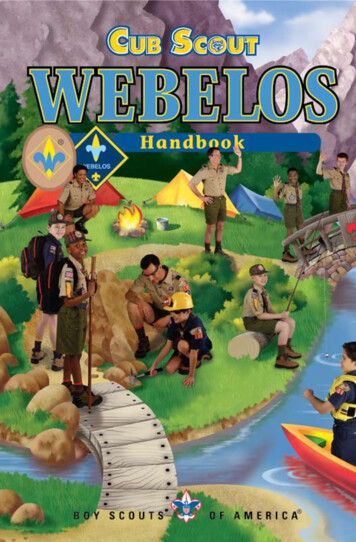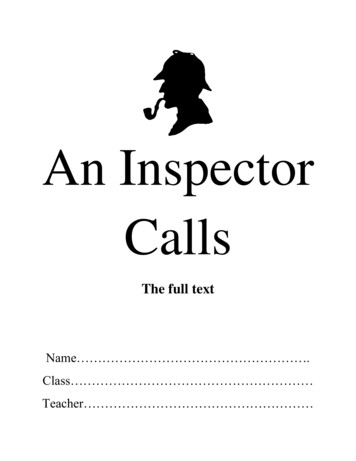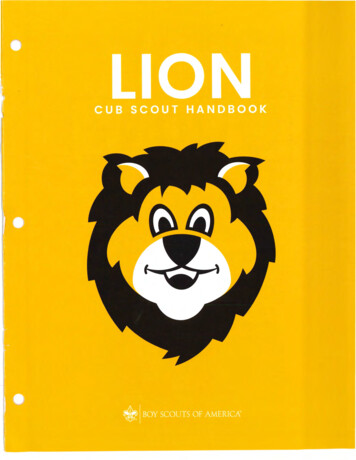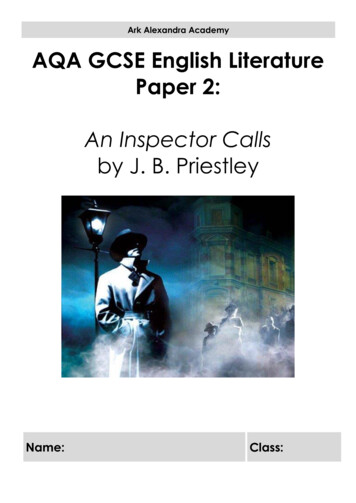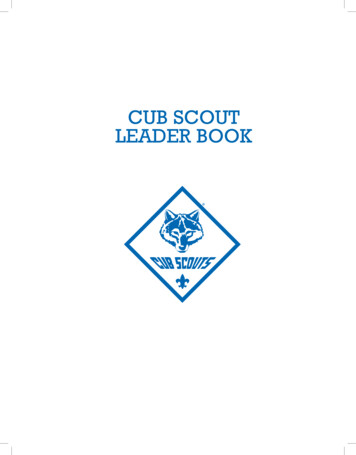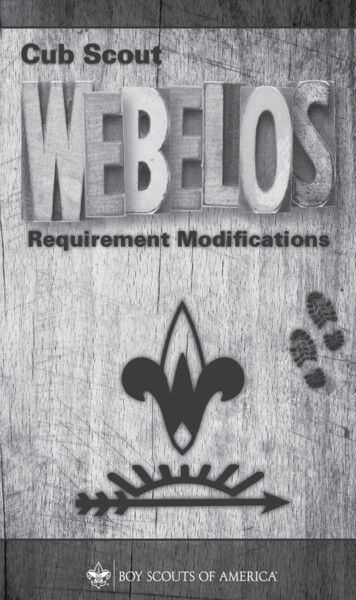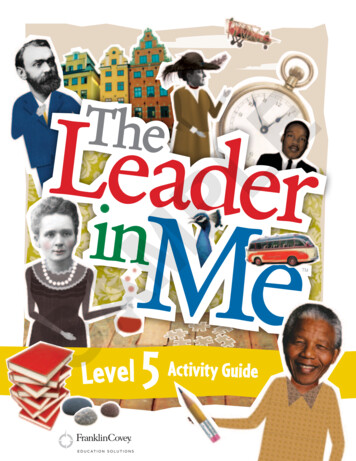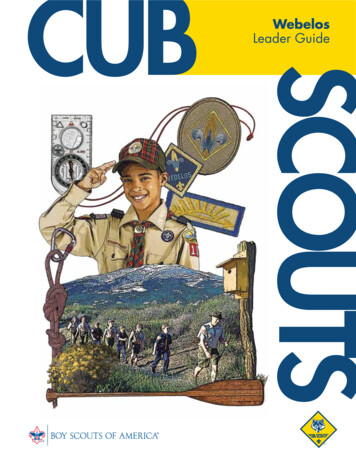
Transcription
WebelosLeader Guide
THANKS TO YOU,MILLIONS OF BOYS BECOME MORE CONFIDENT GROW SPIRITUALLY ARE BETTER CITIZENS LEARN LIFE SKILLS HAVE FUN!WITHOUT YOU, THEY WOULD NOT.The Boy Scouts of America welcomes your comments and suggestionson how to improve this resource.Please e-mail your thoughts to CS.Webelos.Leader@scouting.org.
WEBELOSLEADER GUIDE
A Word About Youth Protection&KLOG DEXVH LV D VHULRXV SUREOHP LQ RXU VRFLHW\ DQG XQIRUWXQDWHO\ LW FDQ RFFXU DQ\ZKHUH HYHQ LQ 6FRXWLQJ RXWK VDIHW\ LV RI SDUDPRXQW LPSRUWDQFH WR 6FRXWLQJ )RU WKDW UHDVRQ WKH %6 FRQWLQXHV WR FUHDWH EDUULHUV WR DEXVH EH\RQG ZKDW KDYH SUHYLRXVO\ H[LVWHG LQ 6FRXWLQJ The Boy Scouts of America places the greatest importance on providing themost secure environment possible for its youth members. To maintain such anenvironment, the BSA has developed numerous procedural and leadershipselection policies, and provides parents and leaders with numerous onlineand print resources for the Cub Scout, Boy Scout, and Venturing programs.Effective June 1, 2010, the BSA implemented mandatory Youth Protectiontraining for all registered volunteers.New leaders are required to take Youth Protection training before submitting anapplication for registration. The certificate of completion for this training must besubmitted at the time the application is made and before volunteer service withyouth begins.Youth Protection training must be taken every two years. If a volunteer does notmeet the BSA’s Youth Protection training requirement at the time of recharter,the volunteer will not be reregistered.We encourage all adults to take the BSA’s Youth Protection training.To find out more about the Youth Protection policies of the Boy Scouts ofAmerica and how to help Scouting keep your family safe, see the Parent’sGuide in any of the Cub Scouting or Boy Scouting handbooks, or go .aspx.33853ISBN 978-0-8395-3853-0 2001 Boy Scouts of America2010 Revision
CONTENTSIntroduction . . . . . . . . . . . . . . . . . . . . . . . . . . . . . . . . . . . . . . . . . . . . . . . . . . . . . . . . . . . . . . . . . . . . . . . . . . . 1History of the Webelos Program . . . . . . . . . . . . . . . . . . . . . . . . . . . . . . . . . . . . . . . . . . . . . . . . . . . . . . . . . . . 1Tips for Success as a Webelos Den Leader . . . . . . . . . . . . . . . . . . . . . . . . . . . . . . . . . . . . . . . . . . . . . . . . . . . 2Base Plan for Webelos Den Meetings . . . . . . . . . . . . . . . . . . . . . . . . . . . . . . . . . . . . . . . . . . . . . . . . . . . . . . . 3Base Plan for Webelos and Arrow of Light . . . . . . . . . . . . . . . . . . . . . . . . . . . . . . . . . . . . . . . . . . . . . . . . 5A Pack Chartered by the Church of Jesus Christ of Latter-day Saints . . . . . . . . . . . . . . . . . . . . . . . . . . 6Training, Recognition, and Program Literature for Webelos Den Leaders . . . . . . . . . . . . . . . . . . . . . . . . . 7Webelos Badge Requirement Activities . . . . . . . . . . . . . . . . . . . . . . . . . . . . . . . . . . . . . . . . . . . . . . . . . . . . . . 7Arrow of Light Award Requirement Activities . . . . . . . . . . . . . . . . . . . . . . . . . . . . . . . . . . . . . . . . . . . . . . . . 9Webelos-to-Scout Transition . . . . . . . . . . . . . . . . . . . . . . . . . . . . . . . . . . . . . . . . . . . . . . . . . . . . . . . . . . . . . 10Webelos Camping . . . . . . . . . . . . . . . . . . . . . . . . . . . . . . . . . . . . . . . . . . . . . . . . . . . . . . . . . . . . . . . . . . . . . . 12Webelos Activity Badge Projects . . . . . . . . . . . . . . . . . . . . . . . . . . . . . . . . . . . . . . . . . . . . . . . . . . . . . . . . . . 15Activity Badge Den Meeting Plans and Project Ideas . . . . . . . . . . . . . . . . . . . . . . . . . . . . . . . . . . . . . 16–116Aquanaut . . . . . . . . . . . . . . . . . . . . . . . 16Geologist . . . . . . . . . . . . . . . . . . . . . . . 66Artist . . . . . . . . . . . . . . . . . . . . . . . . . . . 21Handyman . . . . . . . . . . . . . . . . . . . . . . 71Athlete . . . . . . . . . . . . . . . . . . . . . . . . . 25Naturalist . . . . . . . . . . . . . . . . . . . . . . . 76Citizen . . . . . . . . . . . . . . . . . . . . . . . . . 30Outdoorsman . . . . . . . . . . . . . . . . . . . 81Communicator . . . . . . . . . . . . . . . . . . 36Readyman . . . . . . . . . . . . . . . . . . . . . . 86Craftsman. . . . . . . . . . . . . . . . . . . . . . . 41Scholar . . . . . . . . . . . . . . . . . . . . . . . . . 91Engineer . . . . . . . . . . . . . . . . . . . . . . . . 47Scientist . . . . . . . . . . . . . . . . . . . . . . . . 96Family Member . . . . . . . . . . . . . . . . . . 53Showman . . . . . . . . . . . . . . . . . . . . . . 102Fitness . . . . . . . . . . . . . . . . . . . . . . . . . . 58Sportsman . . . . . . . . . . . . . . . . . . . . . 107Forester . . . . . . . . . . . . . . . . . . . . . . . . . 62Traveler . . . . . . . . . . . . . . . . . . . . . . . . 112iii
INTRODUCTIONThe basic information for planning and conductingWebelos den meetings and activities can be found inthe Den & Pack Meeting Resource Guide and Cub ScoutLeader Book. This Webelos Leader Guide supplementsthe program by providing activity ideas for den meetings, activity badges, advancement requirements, andBoy Scout transition activities.Determining the Webelos program plan for aden will depend on the starting date and transitiondate of your boys. A base plan, derived from the denmeeting plans of the Den & Pack Meeting ResourceGuide, is offered on page 5. This plan will createthe opportunity to earn the Arrow of Light whileboys prepare to become Boy Scouts. The Webelosden leader may modify or reorder this base planto meet the requirements of the den so long as alladvancement requirements are met.You can find ideas in the boys’ Webelos Handbook,the Cub Scout Leader How-To Book, the Cub ScoutAcademics and Sports Program Guide, and Cub ScoutCeremonies for Dens and Packs. You can also getsuggestions, information, and support from fellowleaders, the unit commissioner, and the district training staff, as well as by attending Cub Scout leaderroundtables, pow wows, and universities of Scouting.Finally, a wealth of information is available at theNational Council Web site, www.scouting.org.SAFETY FIRSTIn conducting activities, Webelos den leadersmust maintain adequate supervision and assure theproper use of materials. Be careful, and remember:Safety must always come first!Refer to the latest printing of The Guide to SafeScouting, No. 34416, for information on guidelinesrelating to the many activities in which your Webelosden may participate.The Guide to Safe Scouting is available from yourlocal council service center, or you can find it on theNational Council Web site at www.scouting.org.PURPOSES OF CUB SCOUTINGIn Cub Scouting, boys, families, leaders, andchartered organizations work together to achieve the10 purposes of Cub Scouting: Character Development Spiritual Growth Good Citizenship Sportsmanship and Fitness Family Understanding Respectful Relationships Personal Achievement Friendly Service Fun and Adventure Preparation for Boy ScoutsHISTORY OF THE WEBELOS PROGRAMIn 1902, Ernest Thompson Seton started an outdoor program for boys called the Woodcraft Indians.In 1910, he became one of the founders of the newBoy Scout movement and one of its best-knownpromoters. During the 1920s, he helped Dr. HuberWilliam Hurt develop the Cub program, and by1928, Cubbing units were field tested in each of theBSA’s regions. On April 1, 1930, the first pack charters were issued for the new Cubbing program (notofficially called Cub Scouting until 1945). The firstpiece of Cubbing literature, The Boy’s Cubbook, wasalso published in 1930.The new program adapted activities, games, andceremonies from other youth groups, such as Seton’sWoodcraft Indians; Wolf Cubbing, developed inEngland by Lord Baden-Powell; and the Boy Rangersof America. American Indian lore was emphasized.In the first handbooks, Akela was an AmericanIndian boy, son of the chief of the Webelos Tribe.“Webelos” was explained as “a word with an innermeaning, signifying progress from Wolf throughBear and Lion Ranks to Scout: W-B-L-S We’ll BeLoyal Scouts.” The chief of the Webelos Tribe wasnamed Arrow of Light, which was adapted from theArrow Park World Jamboree in London in 1929,when the Golden Arrow was made the symbol ofworld friendship.The Cubbing story told of the boy Akela beingtaken on trips into the forest where he learnedknowledge and skills from the wolf and the bear.Before he could become a Scouting “brave,” he hadto look the lion in the eye and learn courage anddetermination. Then, he was admitted to the lowerranks of the young “braves,” the Scouts of the trail,advancing (at the age of 12) from the world brotherhood of Cubs into the world brotherhood of Scouts.1
In later years, the name Akela was used for thechief of the tribe or pack. By 1980, a parent, an olderbrother or sister, or an adult friend could be Akela andhelp the Cub Scout along the advancement trail.In the 1930s, Cubbing organization structure waslike today’s Cub Scouting, except that dens were ledby Boy Scout den chiefs. Dens met weekly at a member’s home for games, den competitions, advancementawards, stunts, and other activities. A Cub’s advancement was from Bobcat (all new members) to Wolf (9years old), Bear (10 years old), and Lion (11 years old).But the dropout rate was high in Cubbing, so in1953, a Cub Scout advisory group began studyinga proposed Webelos den plan to help create morevariety in the program for older boys. In 1954, theWebelos den was created for 101 2-year-old boys, witha new Webelos den badge. The first Lion-WebelosBook with meeting outlines helps for Webelos leaderswas introduced in 1958.In 1988, a two-year Webelos Scout program wasrecommended; however, the changes weren’t fullyimplemented until 1989. These changes includedan expanded outdoor program with more opportunities for boy leadership, which would provide abetter vehicle for Webelos Scouts to progress intoBoy Scouting.The Webelos den program of the 21st century is anexciting adventure for boys, their families, and theirleaders. The activity badges, the outdoor program, theopportunities for boy leadership, and the preparationfor boys to leave Cub Scouting and embark on theadventure of Boy Scouting are all wonderful steps forboys to take on the road to becoming a First Class BoyScout and then soaring on to Eagle.TIPS FOR SUCCESS AS A WEBELOS DEN LEADERPREPARE TO “DO YOUR BEST.” Prepare yourselfto “Do Your Best” as a Webelos den leader by focusingon the leader materials and training you should haveto best serve your Webelos Scouts. As a Webelos denleader, you should own or have taken:BEFORE YOURFIRST DENMEETINGYOU SHOULD OWN Den & Pack MeetingResource GuideWebelos Leader GuideTRAINING YOUYouth Protection1MUST TAKEDen Leader Fast Start1(TO BECOME ATRAINED LEADER)TRAININGYOU SHOULDCONSIDERAS YOU ADVANCE(WITHIN 3 TO 4MONTHS)Cub ScoutLeader BookLeader PositionSpecific Training1, 2This Is Scouting1Basic AdultLeader OutdoorOrientation(BALOO)2Outdoor LeaderSkills for WebelosDen Leaders21Mandatory as of June 1, 2010; available as online training atwww.scouting.org/Training.aspx.2Available as in-person training. Consult your pack trainer orlocal council office.PARENTAL OR GUARDIAN INVOLVEMENT.Don’t try to carry the load yourself. Involve parentsor guardians and encourage them to lend expertise to the program as activity badge counselors intheir areas of interest. Each parent has something tocontribute. Invite them to participate and use theirskills. Use “two-deep leadership,” which means thattwo adults are required for all outings or activities.2PROGRAM PLANNING. The base plan forWebelos dens on page 5 offers one way to plan yourWebelos and Arrow of Light den meetings to assurethat your boys have the opportunity to earn theWebelos and Arrow of Light awards. There are manyother possible approaches that might be utilized bya Webelos den leader. The key to using alternate denplans is following these steps:1. Prepare your plan. Considerations should includeyour start date for den meetings, how frequently youwill meet, the ages of your Webelos Scouts (whetherthey are all in the same Webelos year or not), andcritically, the rank requirements (see page 3).2. Evaluate your plan. After you have your planworked out, share it with other leaders. PastWebelos den leaders, your Cubmaster, or unitcommissioners are good choices.3. Execute your plan. There is nothing like doing it tosee if it’s working.4. Modify your plan. Making early corrections—ifthey are needed—may be important to your boysreaching their rank advancement.Always be guided by the desire to have your boysadvance in rank by blue and gold (February) so theycan continue to work on compass points, achievetheir Arrow of Light, and transition to Boy Scouts.PARTICIPATION. Help the boys and their parentsenjoy their participation in Webelos Scouting. Allowyour Webelos Scouts to develop their leadershipskills at pack meetings and pack activities. At pack
meetings, encourage them to demonstrate activitybadge projects they have completed.WEBELOS-TO-SCOUT TRANSITION. One ofthe purposes of Cub Scouting is to prepare boys forBoy Scouting. The Webelos den program is the keytime for this preparation. Learn which Boy Scouttroops are active in your area and get acquaintedwith the Scoutmasters. Participate in joint Webelosden and Boy Scout troop outdoor activities. Withyour Webelos den, visit some troop meetings duringthe year. Ask the Scoutmaster(s) to attend the transition ceremony and welcome the boys into the troop.Everything you can do to encourage a boy to continue in Boy Scouting is helpful, including moving intoa Boy Scout troop along with your Webelos Scouts.SUCCESS. Leadership is learned and developed.You can become an effective Webelos den leader ifyou complete basic training, plan interesting denmeetings, and take the time to understand the boys.Become familiar with the Webelos Handbook andprovide opportunities for advancement. One of yourbest resources is your district’s monthly Cub Scoutleader roundtable, where you can exchange ideaswith other Webelos den leaders. Remember to beflexible in your planning. Have fun in the program.Be thankful for the opportunity you have to workwith boys and influence their lives. There is greatsatisfaction in helping boys learn good values andworthy skills along their way to becoming adults.BASE PLAN FOR WEBELOS DEN MEETINGSThe base plan for Webelos den meetings on page5 is one plan for Webelos and Arrow of Light dens.This plan is based on dens starting their den meetings in September and concluding in May. This planis related directly to the den meeting plans in the Den& Pack Meeting Resource Guide. Its plans, if followed,will have your boys advancing to the Webelos rank by blue and gold inFebruary of Webelos Year 1; achieving the compass point badge and compasspoints from February through May; achieving the Arrow of Light in February ofWebelos Year 2; and, transitioning to Boy Scouts.Developing a PlanThe base plan is not the only possible plan.Implementing the Webelos program for WebelosScouts will depend on the starting date and transition date of the boys in the den. Activity badges, theWebelos badge, and the Arrow of Light Award requirements are other factors that you need to consider.The Webelos badge, compass points, Arrow ofLight, and activity badges are explained in detail inthe Webelos Handbook, but the basic requirementsare listed below.Webelos Badge RequirementsBoys must do the following:1. Have an adult member of the family read the “Webelos Scout ParentGuide” in the Webelos Handbook andsign in the handbook.2. Be active in the den for three months.3. Know and explain the meaning ofWebelos badge.the4. Point out and explain the three special parts ofthe Webelos Scout uniform. Tell when to wear theuniform and when not to wear it.5. Earn the Fitness and Citizen activity badges andone other from a different activity group.6. Plan and lead a flag ceremony in your den thatincludes the U.S. flag.7. Show that they know and understand the requirements to be a Boy Scout.8. Earn the religious emblem of their faith or do two ofsix requirements related to their religious beliefs.Compass Points EmblemBoys must do the following:1. Earn the Webelos badge.2. Earn four more activity badges for atotal of seven to receive the compasspoints emblem.3. Earn one compass point for eachadditional four activity badges: Earn a total of 11 activity badges—first point. Earn a total of 15 activity badges—second point. Earn a total of 19 activity badges—third point.Arrow of Light RequirementsBoys must do the following:1. Be active in their Webelosden for at least six monthsafter completing the fourth grade (or for at leastsix months after becoming 10 years old), and earnthe Webelos badge.2. Show your knowledge of the requirements tobecome a Boy Scout by doing all of these: Repeat from memory and explain the Scout Oathor Promise and the 12 points of the Scout Law. Tellhow they have practiced them in everyday life.3
Give and explain the Scout motto, slogan, sign,salute, and handshake. Understand the significance of the First ClassScout badge. Describe its parts and tell whateach stands for. Tell how a Boy Scout uniform is different froma Webelos Scout uniform. Tie the joining knot (square knot).3. Earn five more activity badges in addition tothe three earned for the Webelos badge. Thetotal must include Fitness, Citizen, Readyman,Outdoorsman, at least one from the Mental Skillsgroup, at least one from the Technology group,and one of his choice.4. With the Webelos den, visit a Boy Scout troopmeeting and a Boy Scout–oriented outdoor activity.5. Participate in a Webelos overnight campout or dayhike.6. After completing all five of the above requirements,and after a talk with the Webelos den leader, arrangeto visit, with his parent or guardian, a meeting ofa Boy Scout troop he thinks he might like to join.Have a conference with the Scoutmaster.7. Complete the Honesty Character Connection.NOTE: Boys earning activity badges using the CubScout Academics and Sports program must earn pinsand/or belt loops during the Webelos Scout year.CHARACTER CONNECTIONS INTHE WEBELOS DEN PROGRAMHow to Make More CharacterConnections With Other ActivitiesCharacter Connections are outlined for a boyand his leader to follow as the boy completes therequirements in the Webelos Handbook. What aboutincluding Character Connections in other activities?Webelos den leaders may emphasize more valuesand make more Character Connections as boys participate in the many activities they enjoy in Scouting.Leaders can highlight values while going on a hike,cooking an outdoor meal, or making a project. A CoreValue can be connected to an activity very easily.How do leaders make a Character Connection?With an easy three-step method:1. Plan it.2. Do it.3. Review it.Plan it. Before the activity, gather the group andhave a short discussion. Planning the CharacterConnection takes only a couple of minutes.4Highlight one or two values that you would likethe boys to learn through the activity. Will they need to show respect? Will they need to be honest? Will they need to cooperate? Will they need a positive attitude?Identify the ways that youth might encounterthese values in the activity. Will they experience challenges or difficulties? Will they need to cooperate with others? Will they face temptations? Will they need to follow rules?Explain leader expectations about the values in theactivity. Why will these values be important during thisactivity? How can boys use these values during this experience? What rules and consequences apply to these valuesduring the experience?Do it. Conduct the activity. Highlight positive ornegative experiences that are teachable moments during the activity. Some teachable moments must beemphasized as they happen; they may lose their effectif discussed at a later time. Others can be emphasizedduring the review at the end of the activity.Make mental or written notes from the experiencethat could be discussed after the activity.Review it. After the activity, gather the group andhave a discussion that involves all boys. Celebrate positive examples of where the values were demonstratedduring the activity. Highlight areas for improvement.What part of the value does the group need to practice? What did the group learn about using the value?Determine ways boys can use the value at home, atschool, or in other areas of their lives.DENS WITH NEW FIFTH-GRADEWEBELOS SCOUTSA new fifth-grader starts by earning his Bobcatbadge. He will need significant parental support if heis to earn his Arrow of Light before it is time to crossover into a Boy Scout troop.Minimize the disruption to the den schedule byhaving the new fifth-grader participate in ongoingden activities, plus completing the minimum number of first-year requirements (Bobcat and Webelosbadge requirements). He will work on five badgesfrom the year he missed: Fitness, Outdoorsman,Family Member, Handyman, and Traveler or Artist.
BASE PLAN FOR WEBELOS AND ARROW OF LIGHTMonthDen Meeting Plan No./BadgeRank, Sports Requirements,Character ConnectionsYear 1–WebelosSeptember1. Fitness and Athlete2. Forester and NaturalistBobcat review (as necessary)Physical Fitness pin2HA*: Fitness 2–7, Athlete 4–7October3. Forester and Naturalist4. Traveler and FitnessWebelos requirements 3, 4, 7HA*: Webelos requirement 8 (Faith)Geography belt loop2; Map and Compassbelt loop2November5. Citizen6. CitizenCitizen belt loop1HA*: Citizen belt loop 1, 3December7. CitizenMake up as neededWebelos requirements 3, 4, 7January8. Citizen and ArtistMake up as neededWebelos requirements review and make upas neededAt the end of January, Webelos Scouts may earn their Webelos badge based on having completed the achievements in this plan. See page 3 ofthis resource or page 49 of the Webelos Handbook for a summary of Webelos requirements. The Webelos badge is often presented at blue andgold banquet in February.After boys have earned the Webelos badge, they can earn the compass points emblem. It is awarded after they earn seven activity badges, fourmore in addition to the three they earned for the Webelos badge.February9. Geologist10. GeologistGeology belt loop2 .March11. Engineer12. EngineerMathematics belt loop2April13. Craftsman14. CraftsmanMay15. Scholar and ArtistJuneJulyAugustChess belt loop2Summertime is a great opportunity to extend and continue the Webelos experience.Consider camping opportunities (day camp, resident camp, and council-organized familycamps) that may be used to continue earning activity badges.Year 2–Arrow of LightSeptember1. Family Member2. AquanautOctober3. Outdoorsman4. SportsmanTwo individual and two team sports belt loops1November5. Scientist6. ScientistArrow of Light reviewDecember7. ReadymanJanuary8. Readyman9. ReadymanThe end of January is the earliest that second-year Webelos Scouts may earn the Arrow of Light Award based on this plan. Webelos Scoutswho earn the Arrow of Light may become Boy Scouts immediately, even though they have not turned 11 or graduated from the fifth grade.February10. Arrow of Light11. HandymanMarch12. Sportsman13. CommunicatorTwo individual and two team sports belt loops1April14. Sportsman15. SportsmanTwo individual and two team sports belt loops11Belt2Beltloop is required for the activity badgeloop is one of a number of options for the activity badgeHA* Home assignment5
A PACK CHARTERED BY THE CHURCHOF JESUS CHRIST OF LATTER-DAY SAINTSA boy enters a Webelos den chartered by the Church of Jesus Christ of Latter-day Saints (LDS) when heturns 10 years old and remains in the Webelos program until his 11th birthday, at which time he enters thepatrol for 11-year-old Scouts.Using the Webelos Leader Guide, Webelos den leaders may plan den activities for the year. Often, twoactivity badges may be earned during one month. Leaders may calendar the monthly themes as outlined inthe suggested schedule below.SUGGESTED ryFebruaryMarchAprilMayJuneJulyAugustACTIVITY neerAthleteEngineerSportsmanFamily GeologistNaturalistForesterRegardless of the month a boy enters the Webelosprogram, he can achieve the requirements for theWebelos badge and the Arrow of Light Award duringthe Webelos year.KEY TOSUGGESTED SCHEDULEItalicsRequired for Arrow of Light Award*LDS Webelos Scouts are encouraged to earnthe Family Member activity badge.**LDS Webelos dens follow the overnightcamping guidelines found in the LDSScouting Handbook: “No Scout-sponsoredovernight camping should be planned forboys under age eleven.”Family camping experiences that includeactivities for Webelos requirements should becoordinated with the Webelos den leader andapproved by local priesthood leaders.As each boy enters the Webelos program: He should begin to work on the requirements to earn the Webelos badge immediately while also participating in weekly den activities. Requirements are listed in the Webelos Handbook. To earn the Webelos badge,an LDS Scout should earn the Faith in God emblem. He is permitted to earn this award at any time duringhis Cub Scout years, after he is 9 years old. The leader introduces the boy and his parents to the requirements for the Webelos badge and a one-yearplan that includes all of the necessary achievements for the boy to receive the Arrow of Light Award by thetime he enters the patrol for 11-year-old Scouts. With the help and encouragement of his leader and hisfamily, he can complete the requirements listed in the Webelos Handbook.6
TRAINING, RECOGNITION, AND PROGRAMLITERATURE FOR WEBELOS DEN LEADERSTRAININGYouth Protection training1Cub Scout Den Leader Fast Start training1Cub Scout leader-specific training1,2This Is Scouting1Outdoor Leader Skills for Webelos Leaders21Mandatory as of June 1, 2010; available as onlinetraining at www.scouting.org/Training.aspx.2Available as in-person training. Consult your packtrainer or local council office. RECOGNITIONThe Webelos Den Leader Award is for Webelosden leaders completing training, performance, andtenure requirements. Requirements are found in theCub Scout Leader Book.PROGRAM LITERATUREThe Webelos Handbook, No. 33452, is the boys’handbook and includes the requirements thatWebelos Scouts need to complete to earn activitybadges, the Webelos badge, and the Arrow of LightAward. The book also contains a “Webelos ScoutParent Guide” designed to help parents understandCub Scouting and another guide for parents titledHow to Protect Your Children From Child Abuse.The Den & Pack Meeting Resource Guide,No. 34409, is a detailed guide for all den leaders.In this resource guide, you will find individualden meeting plans that will guide you and yourboys to rank advancement. These plans also outlinethe planning and materials requirements for eachadvancement activity so that den leader planningis facilitated.The Cub Scout Leader Book, No. 33221, is a guidefor all Cub Scout leaders. It contains the basic information needed to operate and support Cub Scouting,such as information on Cub Scout policies, leadershipduties, program planning, and youth protection.The Cub Scout Leader How-To Book, No. 33832,includes a broad assortment of time-tested programactivities for Cub Scout dens and packs. By usingthese activities, leaders not only help strengthen family relationships but provide opportunities for boysto have fun while they are advancing in rank.The Cub Scout Academics and Sports ProgramGuide, No. 34299, helps pack leadership use thissupplemental enrichment program to complementthe existing Webelos Scout program. It includesinformation about and the requirements for eachacademic and sport subject covered by the program.WEBELOS BADGE REQUIREMENT ACTIVITIESWhen a boy earns theWebelos badge, he learnsmany of the requirementsfor the Scout badge. Whenhe has completed the Arrowof Light requirements, hewill have completed mostof the joining requirementsto become a Boy Scout. TheBoy Scout Handbook, No. 34554,lists the joining requirements.A Webelos Scout begins working on the Webelosbadge as soon as he joins the Webelos den. TheWebelos den leader, assistant den leader, and denchief can all help the boys learn the requirements forthe Webelos badge. If there are experienced WebelosScouts in the den who have already earned the badge,they too can help. Webelos badge requirementscan be worked into the den meeting as an openingceremony, a gathering-time activity, a game, or aclosing ceremony.When working on the Webelos badge in denmeetings, the boys can be divided into two groups—the learning group and the doing group. New WebelosScouts will become acquainted with the requirements, and the older boys will practice them.Use the Webelos Handbook as a reference. It tellsexactly what the boys must know and do to earnthe badge.The requirements for the Webelos badge and theArrow of Light Award are related, one building onthe other. Both require earning activity badges.7
SCOUT REQUIREMENT QUIZOUTDOOR CODETo earn the Webelos badge, the boys are notrequired to memorize the Scout Oath, Scout Law,slogan, and motto, although many of them probablywill. The important thing is that they understandthe meanings. They are explained simply in theWebelos Handbook and covered in more detail in theBoy Scout Handbook. These can be incorporated inopening and closing ceremonies at den meetings.Quiz the boys on their understanding of the Oath,Law, motto, and slogan by having one boy read a partof each aloud and having another boy explain themeaning to the group.One of the Webelos ba
the Cub Scout Leader How-To Book, the Cub Scout Academics and Sports Program Guide, and Cub Scout Ceremonies for Dens and Packs. You can also get suggestions, information, and support from fellow leaders, the unit commissioner, and the district train-ing staff,
